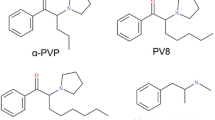Summary
Following intraperitoneal administration of the non-competitive N-methyl-D-aspartate (NMDA) antagonist dizocilpine (MK-801), levels of the dopamine (DA) metabolites 3,4-dihydroxyphenylacetic acid (DOPAC) and homovanillic acid (HVA) increased in mouse striatum and limbic forebrain. When dizocilpine was given to animals treated with NSD 1015, an inhibitor of 3,4-dihydroxyphenylalanine (DOPA) decarboxylase and monoamine oxidase, there was an increase in levels of DOPA and 3-methoxytyramine (3-MT). These findings suggest that dizocilpine stimulates DA synthesis and release in mouse brain. Following dizocilpine treatment a clear-cut increase in spontaneous locomotor activity was observed, probably partly due to enhanced dopaminergic tone. The competitive NMDA antagonist D-CPPene produced locomotor stimulation as well, but in contrast to following dizocilpine treatment levels of 3-MT decreased. Thus the stimulation of locomotor activity following D-CPPene treatment does not seem to be mediated through activation of central dopaminergic systems. However, haloperidol pretreatment antagonized this locomotor response, indicating that the dopaminergic system plays a permissive role in this context.
Similar content being viewed by others
References
Aebischer B, Frey P, Haerter HP, Herrling PL, Mueller W, Olverman HJ, Watkins JC (1989) Synthesis and NMDA antagonistic properties of the enantiomers of 4-(3-phosphonopropyl)piperazine-2-carboxylic acid (CPP) and of the unsaturated analogue (E)-4-(3-phosphonoprop-2-enyl)piperazine-2-carboxylic acid (CPPene). Helv Chim Acta 72: 1043–1051
Bennet DA, Bernard PS, Amrick CL, Wilson DE, Liebman JM, Hutchison AJ (1989) Behavioral pharmacological profile of CGS 19755, a competitive antagonist at N-methyl-D-aspartate receptors. J Pharmacol Exp Ther 250: 454–460
Carlsson A, Hillarp NE (1962) Formation of phenolic acids in brain after administration of 3,4-dihydroxyphenylalanine. Acta Physiol Scand 55: 95–100
Carlsson A, Lindqvist M (1963) Effect of chlorpromazine or haloperidol on formation of 3-methoxytyramine and normetanephrine in mouse brain. Acta Pharmacol Toxicol 20: 140–144
Carlsson A, Lindqvist M (1973a) Effect of ethanol on the hydroxylation of tyrosine in rat brain in vivo. J Pharm Pharmacol 25: 437–440
Carlsson A, Lindqvist M (1973b) In vivo measurements of tryptophan and tyrosine hydroxylase activities in mouse brain. J Neural Transm 34: 79–91
Carlsson M, Carlsson A (1989a) The NMDA antagonist MK-801 causes marked locomotor stimulation in monoamine-depleted mice. J Neural Transm 75: 221–226
Carlsson M, Carlsson A (1989b) Dramatic synergism between MK-801 and clonidine with respect to locomotor stimulatory effect in monoamine-depleted mice. J Neural Transm 77: 65–71
Carlsson M, Svensson A (1990a) Interfering with glutamatergic neurotransmission by means of NMDA antagonist administration discloses the stimulatory potential of other transmitter systems. Pharmacol Biochem Behav 36: 45–50
Carlsson M, Svensson A (1990b) The non-competitive NMDA antagonists MK-801 and PCP, as well as the competitive NMDA antagonist SDZ EAA494 (D-CPPene), interact synergistically with clonidine to promote locomotion in monoamine-depleted mice. Life Sci 47: 1729–1736
Clineschmidt BV, Martin GE, Bunting PR, Papp NL (1982a) Central sympathomimetic activity of (+)-5-methyl-10,11-dihydro-5H-dibenzo(a,d)cyclohepten-5,10-imine (MK-801), a substance with potent anticonvulsant, central sympathomimetric and apparent anxiolytic properties. Drug Dev Res 2: 135–145
Clineschmidt BV, Martin GE, Bunting PR (1982b) Anticonvulsant activity of (+)-5-methyl-10,11-diydro-5H-dibenzo(a,d)cycloheptan-5,10-imine (MK-801), a substance with potent anticonvulsant, central sympathomimetic and apparent anxiolytic properties. Drug Dev Res 2: 135–145
Girault J-A, Halpain S, Greengard P (1990) Excitatory amino acid antagonists and Parkinson's disease. Trends Pharmacol Sci 13: 325–326
Hyttel J, Larsen J-J, Christensen AV, Arnt J (1985) Receptor-binding profiles of neuroleptics. In: Casey DE, Chase TN, Christensen AV, Gerlach J (eds) Dyskinesia research and treatment. Springer, Berlin Heidelberg New York Tokyo (Psychopharmacology [Supp 12]: 9–18)
Imperato A, Scrocco MG, Bacchi S, Angelucci L (1990) NMDA receptors and in vivo dopamine release in the nucleus accumbens and caudatus. Eur J Pharmacol 187: 555–556
Kehr W (1981) 3-Methoxytyramine and normetanephrine as indicators of dopamine and noradrenaline release in mouse brain in vivo. J Neural Transm 50: 165–178
Maragos WF, Penney JB, Young AB (1988) Anatomic correlation of NMDA and3H-TCP-labeled receptors in rat brain. J Neurosci 8: 493–501
Martin GE, Papp NL (1984) Blockade of MK-801 induced ipsiversive turning in 6-OHDA lesioned rats by α1-adrenoceptor antagonists. Pharmacol Biochem Behav 20: 893–897
O'Neill KA, Liebman JM (1987) Unique behavioral effects of the NMDA antagonist, CPP, upon injection into the medial pre-frontal cortex of rats. Brain Res 435: 371–376
Nissbrandt H, Engberg G, Wikström H, Magnusson T, Carlsson A (1988) NSD 1034: an amino acid decarboxylase inhibitor with a stimulatory action on dopamine synthesis not mediated by classical dopamine receptors. Naunyn-Schmiedebergs Arch Pharmacol 338: 148–161
Rao TS, Kim HS, Lehmann J, Martin LL, Wood PL (1990a) Selective activation of dopaminergic pathways in the mesocortex by compounds that act at the phencyclidine (PCP) binding site: tentative evidence for PCP recognition sites not coupled to N-methyl-D-aspartate (NMDA) receptors. Neuropharmacology 29: 225–230
Rao TS, Kim HS, Lehmann J, Martin LL, Wood PL (1990b) Interactions of phencyclidine receptor agonist MK-801 with dopaminergic system: regional studies in the rat. J Neurochem 54: 1157–1162
Schmidt WJ (1986) Intrastriatal injection of DL-2-amino-5-phosphonovaleric acid (AP-5) induces sniffing stereotypy that is antagonized by haloperidol and clozapine. Psychopharmacology 90: 123–130
Tiedtke PI, Bischoff C, Schmidt WJ (1990) MK-801-induced stereotypy and its antagonism by neuroleptic drugs. J Neural Transm 81: 173–182
Westerink BHC, Korf J (1976) Turnover of acid dopamine metabolites in striatal and mesolimbic tissue of the rat brain. Eur J Pharmacol 37: 249–255
Willets J, Balster RL, Leander JD (1990) The behavioral pharmacology of NMDA receptor antagonists. Trends Pharmacol Sci 11: 423–428
Wong EHF, Kemp JA, Priestly T, Knight AR, Woodruff GN, Iversen LL (1986) The anticonvulsant MK-801 is a potent N-methyl-D-aspartate antagonist. Proc Natl Acad Sci USA 83: 7104–7108
Wood PL, Altar A (1988) Dopamine release in vivo from nigrostriatal, mesolimbic and mesocortical neurons: utility of 3-methoxytyramine measurements. Pharmacol Rev 40: 164–187
Author information
Authors and Affiliations
Rights and permissions
About this article
Cite this article
Svensson, A., Pileblad, E. & Carlsson, M. A comparison between the non-competitive NMDA antagonist dizocilpine (MK-801) and the competitive NMDA antagonist D-CPPene with regard to dopamine turnover and locomotor-stimulatory properties in mice. J. Neural Transmission 85, 117–129 (1991). https://doi.org/10.1007/BF01244704
Received:
Accepted:
Issue Date:
DOI: https://doi.org/10.1007/BF01244704




